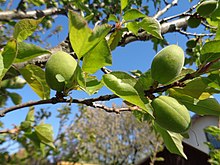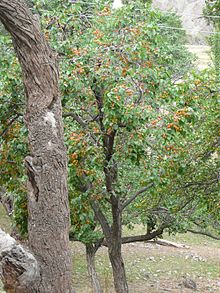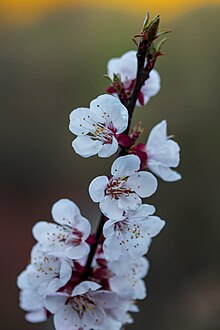apricot
| apricot | ||||||||||||
|---|---|---|---|---|---|---|---|---|---|---|---|---|
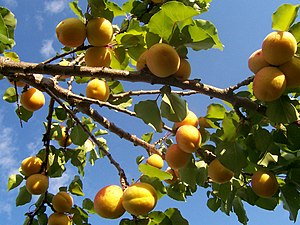
Apricots on the tree |
||||||||||||
| Systematics | ||||||||||||
|
||||||||||||
| Scientific name | ||||||||||||
| Prunus armeniaca | ||||||||||||
| L. |
The apricot ( Prunus armeniaca ), in the Bavarian-Austrian language area (Upper and Lower Bavaria, Upper Palatinate, Austria and South Tyrol) apricot in Rheinhessen also Malete heard as the Siberian apricot and Japanese apricot to Section Armeniaca in the subgenus Prunus of the genus Prunus within the rose family (Rosaceae).
description
The apricot is a deciduous shrub or small tree with a round crown and usually reaches heights of up to 6 meters, rarely up to 10 meters. The trunk circumference reaches 50-100 centimeters. The bark is smooth to scaly or furrowed and gray-brown to reddish. The bark of the branches is bare and reddish in youth. The long shoots have no real terminal bud.
The stalked leaves are 5 to 10 cm long, 3 to 7 cm wide, green in color, egg-shaped to broad-shaped to rounded or slightly heart-shaped, elliptical, suddenly pointed, pointed and rounded to blunt at the base. The leaf margin is single or more often double sawed. The leaves are bare, only in the nerve corners of the underside there is bearded hair. The leaves are rolled in the bud position. The petiole is 2 to 4.5 cm long. On the mostly bare, greenish to reddish petioles there are usually 2 or more glands, these are large and sometimes leafy.
The hermaphrodite flowers with a double flower envelope appearing in front of the leaves are usually arranged individually or, less often, in pairs. Your bud scales fall off when flowering begins. The short peduncle is a maximum of 5 mm long, slightly hairy and often reddish. The flowers are approximately 2.5 cm in diameter. The reddish flower cup is slightly hairy, cup-shaped and secretes nectar inside. The five overgrown sepals , with smaller and recessed tips, are green to red and also slightly hairy and with entire margins. The five, short nailed and spreading, slightly boat-shaped petals are pale pink to white, about 10 to 15 mm long, with a rounded to obovate and entire plate . There are about 20, rarely up to 30 free, protruding stamens on the calyx throat. The stamens are usually white and the anthers are yellow. The medium-sized, single-chambered ovary and often the stylus base have velvety hairs. The long, conical stylus bears a heady scar .
The stone fruit has a diameter of 4 to 8 cm and is almost spherical and rarely ellipsoidal as well as finely velvety hairy, light yellow to orange-red in color and often carmine-red spotted or dotted on the sunny side. It has a longitudinal furrow and is bifurcated at the base. The pulp separates easily from the stone core. The relatively smooth, flattened, rounded to elliptical and light brownish, hard stone core is up to 3 cm long, slightly rough and weakly structured, with individual ribs and furrows on one edge. The seeds taste bitter or sweet.
The flowering period extends from March to April. The number of chromosomes is 2n = 16.
Origin and growing areas
The apricot was already known in Armenia in antiquity and has been cultivated there for so long that it is often assumed that this is their original home. The botanical name is derived from this assumption. For example, De Poederlé wrote in the 18th century: " Cet arbre tire son nom de l'Arménie, province d'Asie, d'où il est originaire et d'où il fut porté en Europe ... " (German: "This tree has its Name of Armenia, an Asian province from which it comes and from which it came to Europe ... ”). An archaeological excavation in Armenia found apricot kernels in a site from the Copper Age . Other sources, such as the geneticist Nikolai Ivanovich Wawilow, locate the genetic origin in China, and yet other sources say that the apricot was first cultivated in India around 3,000 BC.
Traditional apricot growing areas include the Hungarian lowlands. The Turks owned huge apricot plantations at the time of their rule over this plain, but these gardens became deserted after the Turks left. Fruit growing did not begin again in the lowlands until the beginning of the 19th century, when this level threatened to turn into a single sandy desert due to heavy sandstorms . Apricot trees proved to be particularly suitable for binding the drifting sand, as they not only tolerate sandy soil, but also heat and drought. Nowadays apricots are grown especially in Mediterranean countries such as Italy and Spain . However, there is also greater cultivation of these fruits in areas further north, including in the Lower Austrian Wachau , in the Burgenland Kittsee , in the South Tyrolean Vinschgau and in the Swiss canton of Valais .
The world's largest apricot growing area is in the eastern Turkish province of Malatya on the upper reaches of the Euphrates . There the sweet apricots are pitted and dried as a whole fruit. Around 95% of the dried apricots traded in Europe now come from Malatya. For several years now, fresh fruits have also been exported to Europe. The Turkey produced 2017 985.000 t followed by Uzbekistan with 532,565 tons and Italy with 266,372 t, Algeria amounted to 256 890 t in fourth place in world production.
The multiplication takes place mainly through the ooculation .
| rank | country | Production (tons) |
|---|---|---|
| 1 |
|
985,000 |
| 2 |
|
532,565 |
| 3 |
|
266,372 |
| 4th |
|
256,890 |
| 5 |
|
239.712 |
| 6th |
|
178,957 |
| 7th |
|
162,872 |
| 8th |
|
148,500 |
| 9 |
|
131,816 |
| 10 |
|
112,538 |
In Tibet, Ladakh and Northern Pakistan, a small variety of apricots (" Hunza -Apricot") is traditionally grown, which thrives there even at very high altitudes of up to 4000 m.
The apricots are an important source of vitamins and oil and are the only fruit besides sea buckthorn. Cultivation is possible because the apricot tree can survive very deep frosts in winter. The apricots are dried with or without a stone and the apricot kernels are eaten.
Harvest season
The harvest time starts relatively early. Apricots from Central Europe are available from mid-July to late August. In the southern Mediterranean region, the first fruits are harvested from the end of May, the main season finally ends in September. Between December and March, apricots that are flown in from overseas are mainly sold.
Cultural aspects
In Europe, apricots have long been thought of as aphrodisiacs . In this context they also appear in William Shakespeare's A Midsummer Night's Dream and John Webster's The Duchess of Malfi .
In China , the apricot is a symbol of both feminine beauty and the desire for children.
Every year the apricot festival is celebrated in Krems an der Donau , where there are various specialties with the apricot as the main ingredient. Every year the Apricot Kirtag takes place in Spitz an der Donau.
sorts
- Alexandrian black apricot
- Pineapple apricot
- Nancy apricot
- Bergeron
- Early rose apricot
- Great early apricot
- Hargrand
- Heidesheim morning
- Klosterneuburg apricot
- Royal apricot
- Kuresia
- Luizet
- Marena
- Mombacher morning
- Niedersulzer peach apricot
- Orangered
- Melting end of Gaweinstal
- Temperao de Vila Franca
- Hungarian best
- Vinschger apricot
The Wachau apricot is not a variety, but a protected designation of origin .
Etymology and other designations
The word apricot comes from the Latin praecox ("early ripe ") and its variant praecoquium . Via the Byzantine-Greek πρεκόκκια prekókkia , the word got into Arabic asالبرقوق al-barqūq (today alsoمشمش mišmiš ), from which it was in turnborrowedwith the preceding article al- into several Romance languages ( Portuguese albricoque , Spanish albaricoque , from which French abricot ), and finally reached most other European languages via the Romance languages, andfinally alsovia Dutch abrikoos into German. The change from Abri- to Apri-, which took place in German, English and Swedish, may in part be due to phonetic reasons, but is probably due to an incorrect etymology that associated the word with the Latin apricus "sunny". The English lexicographer John Minsheu (1560–1627) found the derivation in aprico coctus "sun-ripened".
The classic Latin name of the fruit, prunum Armeniacum "Armenian plum" or malum Armeniacum "Armenian apple", has been retained in the botanical name. The name apricot, which is prevalent in Austria and South Tyrol and is also known in Bavaria and in Swiss-German (outdated) Barille, Baringel , goes back to this Latin name for the fruit via Italian armellino .
use
The pulp is an ingredient in a variety of dishes, especially Austrian cuisine . Apricot jam gave the apricot its name and apricot jam is an indispensable part of the Sachertorte as well as the filling of carnival donuts . Apricots are the main ingredient u. a. of apricot dumplings and Viennese laundry girls . A large part of the harvest is also distilled into apricot schnapps. Apricot vinegar is also very popular (and expensive).
The seed lies in the apricot stone and looks like a small almond. It tastes bitter and has a strong bitter almond aroma. That is why it is used in the production of Persipan and Amaretto . When crushed, it can be used to flavor sweet dishes. There are also varieties with kernels that taste as sweet as almonds, such as some Turkish apricot varieties. Their shape looks more like a bag, not even and flat. Apricot seeds are poisonous because they contain around eight percent amygdalin which splits off hydric acid. The Federal Institute for Risk Assessment (BfR) therefore advises consumers “not to consume more than one or two bitter apricot kernels per day or to refrain from eating them entirely”. Other sources cite 40 kernels per day as the limit for adults.
According to the association Wachauermarille, apricot fruit (without stone / stone) has a total fruit sugar content of 3 to 16% and, at 200 μg / 100 g, has the highest proportion of provitamin A of all types of fruit .
As a fruit tree, the apricot is a bee forage plant . Your flower nectar has a sugar content of 5 to 22%; Each flower produces 0.31-0.84 mg of sugar in 24 hours.
| Nutritional value per 100 g apricot, raw | |
|---|---|
| Calorific value | 178 kJ (43 kcal) |
| water | 86.8 g |
| protein | 900 mg |
| carbohydrates | 8,540 mg |
| - fiber | 1,540 mg |
| fat | 130 mg |
| Vitamins and minerals | |
| Vitamin A | 267 µg |
| Vitamin B 1 | 40 µg |
| Vitamin B 2 | 53 µg |
| Vitamin B 3 | 770 µg |
| Vitamin B 5 | 290 µg |
| Vitamin B 6 | 70 µg |
| Vitamin B 7 | 1.0 µg |
| Vitamin B 9 | 4 µg |
| vitamin C | 9,400 µg |
| Calcium | 16 mg |
| iron | 650 µg |
| magnesium | 9 mg |
| sodium | 2 mg |
| phosphorus | 21 mg |
| potassium | 280 mg |
| zinc | 102 µg |
| copper | 134 µg |
| manganese | 167 µg |
Others
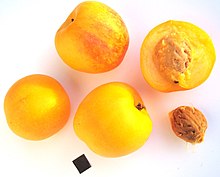
An intersection from
- Nectarine and apricot is called nectacot
- (( Plum x apricot) x plum) is called a pluot
- Plum x apricot (which originated naturally) is called plumcot
- Nectarine and apricot and plum are called nectacotum
- (( Plums x apricot) x apricot) is called aprium
- (( Peach x apricot) x plum ) is called Peacotum
designated.
literature
- Marilena Idžojtić: Dendrology: Cones, Flowers, Fruits and Seeds. Academic Press, 2019, ISBN 978-0-12-819644-1 , p. 513, limited preview in Google Book Search.
Web links
- Prunus armeniaca at plantillustrations.org.
- Prunus armeniaca in the Flora of North America, Vol. 9.
- Prunus armeniaca in Agroatlas, Russia, accessed on August 31, 2019.
- Apricot. In: FloraWeb.de.
- Distribution map for Germany. In: Floraweb .
- Prunus armeniaca L. In: Info Flora , the national data and information center for Swiss flora . Retrieved November 10, 2015.
- Thomas Meyer: Data sheet with identification key and photos at Flora-de: Flora von Deutschland (old name of the website: Flowers in Swabia )
- Wachauer Marille - History of Apricot in Austria and more ( Memento from June 25, 2009 in the Internet Archive )
- Germany's fruit varieties (there “Delivery 15”) Images of some old apricot varieties grown in Germany from the approximately 100-year-old antiquarian booklet series
- Apricot. In: FloraWeb.de.
- Christoph Landolt : Aprikose, Barille, Baringeli, Marille, Amerille - and Äämerich , in: Wortgeschichte dated June 30, 2015, published by the editorial team of Schweizerischer Idiotikons .
Individual evidence
- ↑ a b c d Flora of North America.
- ↑ a b c d e f Hildemar Scholz, Ilse Scholz: Prunus. In: Hans J. Conert u. a. (Ed.): Gustav Hegi : Illustrated flora of Central Europe . Volume 4, Part 2 B: Spermatophyta: Angiospermae: Dicotyledones 2 (3). Rosaceae 2. Blackwell 1995, ISBN 3-8263-2533-8 .
- ↑ a b c Marilena Idžojtić: Dendrology: Cones, Flowers, Fruits and Seeds.
- ^ VII Symposium on Apricot Culture and Decline.
- ↑ De Poerderlé: Manuel de l'Arboriste du et Forestier Belgiques: Seconde Édition: Tome Premier. Published by Emmanuel Flon. Brussels, 1788, p. 160; 682.
- ↑ B. Arakelyan, Excavations at Garni, 1949-50 in Contributions to the Archeology of Armenia. Henry Field, Ed. Cambridge, 1968, p. 160; 29.
- ^ A. Huxley (Ed.): New RHS Dictionary of Gardening. 1, Macmillan Publishers, 1992, ISBN 0-333-47494-5 , pp. 203-205.
- ↑ Kittsee apricot . Entry no. 86 in the register of traditional foods of the Austrian Federal Ministry for Agriculture, Regions and Tourism .. On December 10, 2013 on bmlfuw.gv.at.
- ↑ a b FAOSTAT statistics from 2017. Accessed November 30, 2019 .
- ^ Agha Muhammad Ajmal: Apricot - Temperate Gold of Northern Area of Pakistan. ( Memento of July 17, 2016 in the Internet Archive ) In: Pakistan Times. May 22, 2011.
- ↑ Cultivated in the fruit growing school in Klosterneuburg at the beginning of the 19th century.
- ↑ a b Friedrich Kluge , Elmar Seebold: Etymological dictionary of the German language . 24th edition, de Gruyter, Berlin 2002.
- ^ Statement of the Federal Institute for Risk Assessment of May 3, 2007 ( Memento of June 12, 2007 in the Internet Archive ) (PDF; 109 kB).
- ↑ Ernst Lindner: Toxicology of Food. 4th edition 1990, ISBN 3-8047-1575-3 .
- ↑ Helmut Horn, Cord Lüllmann: The great honey book. Kosmos, Stuttgart 3rd edition 2006, ISBN 3-440-10838-4 , p. 29.
- ↑ https://www.vitamine.com/lebensmittel/aprikose/ Nutritional values apricot

